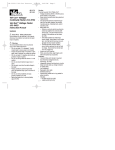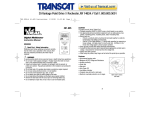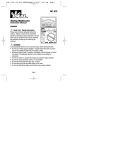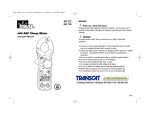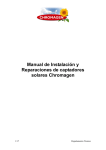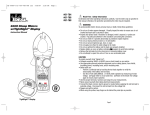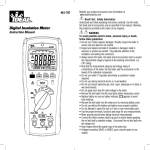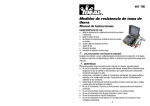Download Voltage Tester Instruction Manual
Transcript
ND 5119-5 61-065 Vol-Con Ins #61-065 Voltage Tester Instruction Manual WARNING Read First: Safety Information Use the tester only as specified in this manual; otherwise, the protection provided by the tester may be impaired. Warning To avoid possible electric shock or personal injury, follow these guidelines: • Do not use tester if it is damaged. Visually inspect tester to ensure case is not cracked. • Inspect and replace leads if insulation is damaged, metal is exposed, or probes are cracked. Pay particular attention to the insulation surrounding the connectors. • Do not use tester if it operates abnormally as protection maybe impaired. • Do not use during electrical storms or in wet weather. • Do not use around explosive gas, dust, or vapor. • Do not apply more than the rated voltage to the tester. Voltage is not to exceed 600V. • Always operate this solenoid-type tester within the specified duty cycle on the front of the tester. Duty cycle ratio is: • 1:7 ON:OFF time for 240V or less • 1:40 ON:OFF time for 240V or greater. • Maximum ON time is 15 seconds. Caution To protect yourself, think "Safety First": • Voltages exceeding 30VAC or 60VDC pose a shock hazard so use caution. • Never ground yourself when taking electrical measurements. 2/19/07 9:18 AM Page 1 • Use appropriate personal protective equipment such as safety glasses, face shields, insulating gloves, insulating boots, and/or insulating mats. • Use the 3-Step Testing Method. Before each use: • Verify tester operation by measuring a known voltage. Apply tester to circuit under test. And, then test on the known live voltage again to ensure proper operation. • Connect the black common lead to ground before applying the red test lead to voltage. Disconnect the red test lead from the voltage first. • Always work with a partner. • When using the probes, keep fingers as far behind the probe tips as possible. Features: • Vibration Mode with indicator movement • Independent solenoid and electronic circuitry design provides back-up voltage indication for added safety • Low Impedance Measuring Device • Replaceable Test Leads • Shielded probe tips • Ultrasonically welded for added durability Accessories: • 61-072 Resistor-fused test leads • C-90 Soft-sided carrying case • 61-010 Leather case To Measure AC Voltage: • Ensure that the plug for the test leads is fully seated into the banana jacks. • Connect the tester in parallel with the load or circuit. • The tester indicates both the voltage type and the voltage level. To Measure DC Voltage: • Ensure that the plug for the test leads is fully seated into the banana jacks. • Connect the tester in parallel with the load or circuit. • The tester indicates the voltage type, polarity, and the voltage level. 2 ND 5119-5 61-065 Vol-Con Ins 2/19/07 Applications: • Locating Blown Fuses With power on: Place tester across the “source” side of one fuse and the load side of an adjoining fuse. If no voltage is indicated, the fuse next to the load side prod is blown. If voltage is indicated, the fuse next to the load side prod is OK. Repeat the same test with the prods on the opposite side of the same two fuses to check the other fuse. On a three phase circuit, repeat the same test as above. An indication of no voltage or lower than normal line voltage indicates the blown fuse. • Testing for 25 to 60 Cycle Frequency Place tester between each side of AC line. A low frequency hum and slow vibrations indicate 25 cycle current. 60 cycle current is indicated by a higher frequency hum and more rapid vibrations. Test Lead Replacement: • Replace leads only with IDEAL test leads below. • # 61-070 Standard Test Leads with Shielded Probe Tips • # 61-072 Resistor-fused Test Leads with Shielded Probe Tips. Each probe tip contains a special, current-limiting resistor which acts like a fuse to limit short-circuit current and prevents dangerous arcing during a shorted condition. The resistors are rated to 140Ω +/- 10%. Fusing current is 1A at 125V. Fusing time is 3060ms at 125V, without causing dangerous conditions during opening of the fuse element. Leads need to be replaced when fuse has opened. 3 9:18 AM Page 3 Maintenance: • Clean the case with a damp cloth and mild detergent. Do not use abrasives or solvents. Service, and Replacement Parts: For replacement parts or to inquire about service information contact IDEAL INDUSTRIES, INC. Attn: Repair Department 1000 Park Avenue Sycamore, IL 60178 Technical Support: 1-877-201-9005 or visit our website at www.testersandmeters.com. Specifications: VAC Ranges: 120V, 240V, 480V, 600V AC. VAC Accuracy: Relative indication only VDC Ranges: 120V, 240V, 600V DC VDC Accuracy: Relative indication only Neon bulb lights from 100-600V AC/DC Operating Frequency: 25-60 Hz Input Impedance: Low Overload protection: 1000VDC/750VAC rms. Operating Environment: 32° F to 122° F (<70% humidity) Storage Temp.: -4° F to 140° F (<80% humidity) Accessories included: Test Leads, operating instructions Dimensions: 7.2" (H), 2.4" (W), 1.5" (D) Weight: 8.0 oz Safety: R 4 99 Washington Street Melrose, MA 02176 Fax 781-665-0780 TestEquipmentDepot.com ND 5119-5 61-065 Vol-Con Ins 2/19/07 Warranty Statement: This tester is warranted to the original purchaser against defects in material and workmanship for five years after purchase. During this warranty period, IDEAL INDUSTRIES, INC. will, at it’s option, replace or repair the defective unit, subject to verification of the defect or malfunction. This warranty does not apply to defects resulting from abuse, neglect, accident, unauthorized repair, alteration, or unreasonable use of the instrument. Any implied warranties arising out of the sale of an IDEAL product, including but not limited to implied warranties of merchantability and fitness for a particular purpose, are limited to the above. The manufacturer shall not be liable for loss of use of the instrument or other incidental or consequential damages, expenses, or economic loss, or for any claim or claims for such damage, expenses or economic loss. State laws vary, so the above limitations or exclusions mat not apply to you. This warranty gives you specific legal rights, and you may also have other rights which vary form state to state. 5 9:18 AM Page 5 #61-065 Probador de voltaje test Manual de instrucciones ADVERTENCIA Lea primero: Información de seguridad Use el probador sólo según se especifica en este manual; de lo contrario, se puede deteriorar la protección proporcionada por el probador. Advertencia Siga estas instrucciones para evitar una posible descarga eléctrica o lesiones personales: • No use el probador si está dañado. Inspeccione visualmente el probador para asegurarse de que la caja no esté agrietada y que la tapa de las pilas esté colocada. • Inspeccione y reemplace los cables si el aislamiento está dañado, el metal está expuesto o las sondas están agrietadas. Preste atención especial al aislamiento que rodea los conductores. • No use el probador si funciona de forma anormal, ya que la protección puede haber disminuido. • No lo use durante tormentas eléctricas o cuando llueva. • No lo use con gases, polvo o vapores explosivos. • No aplique más del voltaje nominal al probador. El voltaje no debe ser mayor que 600 V. • Opere siempre este probador de tipo solenoide dentro del ciclo de servicio especificado en la parte delantera del probador • Tiempo de encendido:apagado 1:7 para 240 V o menos. • Tiempo de encendido:apagado 1:40 para 240 V o más. • El tiempo de encendido máximo es de 15 segundos. 6 ND 5119-5 61-065 Vol-Con Ins 2/19/07 Precaución Para protegerse, piense en la "Seguridad ante todo": • Los voltajes que superen 30 VCA o 60 VCA presentan un peligro de descarga, por lo que debe tener cuidado. • No se conecte nunca a tierra cuando tome medidas eléctricas. • Use equipos de protección personal tales como gafas de seguridad, máscaras, guantes aislantes, botas aislantes y esteras aislantes. • Use el método de prueba de 3 pasos antes de usarlo: • Verifique la operación del probador midiendo un voltaje conocido. Aplique el probador al circuito que se esté probando. Y después pruebe el voltaje conectado conocido para asegurar una operación apropiada. • Conecte el cable común negro a tierra antes de aplicar el cable de prueba rojo al voltaje. Desconecte primero el cable de prueba rojo del voltaje. • Trabaje siempre con un compañero. • Al usar las sondas, mantenga los dedos lo más detrás posible de las puntas de las sondas. Características: • Modalidad de vibración con movimiento de indicador • Diseño de solenoides y circuitos electrónicos independientes que proporciona una indicación de voltaje de reserva para mayor seguridad. • Dispositivo de medida de baja impedancia • Cables de prueba reemplazables • Puntas de sondas blindadas • Soldadas ultrasónicamente que prolongan la duración Accesorios: • Cables de prueba con resistores fusibles 61-072 • Estuche de transporte blando C-90 • Estuche de cuero 61-010 7 9:18 AM Page 7 Para medir el voltaje de CA: • Asegúrese de que el enchufe de los cables de prueba esté completamente asentado en los jacks banana. Conecte el probador en paralelo con la carga o circuito. • El probador indica tanto el tipo de voltaje como el nivel de voltaje Para medir el voltaje de CC: • Asegúrese de que el enchufe de los cables de prueba esté completamente asentado en los jacks banana. • Conecte el probador en paralelo con la carga o circuito. • El probador indica el tipo de voltaje, polaridad y nivel de voltaje (Vea la tabla de operación del probador) Aplicaciones: • Ubicación de fusibles fundidos Con la corriente conectada: Ponga el probador en el lado de "alimentación" de un fusible y el lado de carga de un fusible contiguo. Si no se indica voltaje, el fusible junto a la sonda del lado de carga está fundido. Si se indica voltaje, el fusible junto a la sonda del lado de carga está en buenas condiciones. Repita la misma prueba con las sondas en el lado opuesto de estos dos mismos fusibles para comprobar el otro fusible. En un circuito trifásico, repita la misma prueba que arriba. Una indicación de falta de voltaje o menor que el voltaje de línea normal indica la presencia de un fusible fundido. • Pruebas para una frecuencia de 25 a 60 ciclos Ponga el probador entre cada lado de la línea de CA. Un zumbido de baja frecuencia y vibraciones bajas indican una corriente de 25 ciclos. La corriente de 60 ciclos viene 8





